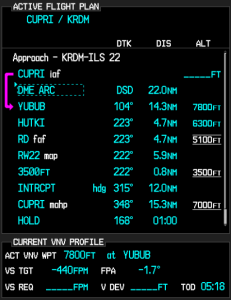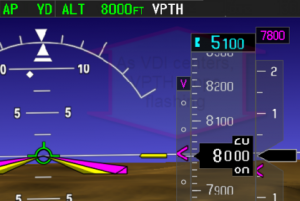There’s a corollary to the old saying that no flight is perfect: You learn something every flight.
The other day, I was giving instrument instruction in a Lancair Evolution equipped with the G900X (Garmin’s experimental version of the G1000 series of glass panels). During that flight, the vertical navigation (VNV) feature failed to perform as expected. This will come as no surprise to G1000 pilots, as VNV is one of the most finicky G1000 feature. However, I was able to capture exactly what happened and re-created it back in the office on the G1000 PC Trainer. What I learned caused me to change my VNV procedures.
Quick VNV Review
 The G1000 flight plan supports vertical profiles in the form of VNV waypoints (marked by blue altitude numbers). In the example on the left, the vertical flight plan has us crossing YUBUB at 7,800′ and HUTKI at 6,300′.
The G1000 flight plan supports vertical profiles in the form of VNV waypoints (marked by blue altitude numbers). In the example on the left, the vertical flight plan has us crossing YUBUB at 7,800′ and HUTKI at 6,300′.
When a whole myriad of conditions are met, the G1000 will select the next blue altitude and calculate a Current VNV Profile. In this case, it has calculated that the Top-of-Descent (TOD) to cross YUBUB at 7,800′ will occur in 5 minutes and 18 seconds.
Once there is a Current VNV Profile, you can configure the GFC700 autopilot to capture and track the vertical guidance provided by the VNV profile, also known as the “VNV Path”.
 In this example on the right, the aircraft is currently flying at 8,000′ MSL, and we have armed VNV path capture as indicated by the white “VPTH”. One condition that must be met is that the selected altitude must be below the VNV profile, so we set the selected altitude to 5,100 (the minimum altitude at the final approach fix). The VNV altitude from the profile is 7,800.
In this example on the right, the aircraft is currently flying at 8,000′ MSL, and we have armed VNV path capture as indicated by the white “VPTH”. One condition that must be met is that the selected altitude must be below the VNV profile, so we set the selected altitude to 5,100 (the minimum altitude at the final approach fix). The VNV altitude from the profile is 7,800.
Normally, as you approach the VNV Profile, the following occurs:
- One minute from TOD, you get a flashing annunciation warning you of the upcoming descent.
- The vertical deviation indicator (VDI) appears with a magenta caret.
- As the VDI centers, VPTH mode becomes active (green) and the aircraft starts descending along the VNV path.
Do You Really Want To Descend?
There is a little-known, often mis-understood “feature” of the autopilot VNV Path support: if you arm VPTH more than five minutes prior to TOD, you must re-confirm VPTH as you approach TOD. In essence, the G1000 is saying that it’s been so long since you’ve issued the command, you may not mean it any more, so confirm you still mean it.
Normally, the way this works is at the one-minute TOD warning, the VPTH annunciator will start to flash. If you press the autopilot VNV button, that will re-arm VPTH and everything will proceed normally.
The following video shows what happens if you do not re-arm VPTH. The autopilot remains in altitude hold mode, and after you cross through the vertical profile, VPTH stops flashing. The aircraft does not descend as planned.
Until today, I taught my students that the flashing VPTH annunciator was a trigger that should cause them to re-arm VPTH. Presumably, this would cover the cases where it had been more than five minutes since arming VPTH in the first place.
VPTH Does Not Always Flash As It’s Supposed To
However, I discovered that VNV does not always flash as it’s supposed to. In particular, if you are already at the first VNV Profile altitude, VPTH will not flash to remind you to re-arm it.
 Once you get inside the one-minute-to-TOD window, the G1000 calculates a vertical speed required (VS REQ) to descend along the profile. You can see on the left, that when you are already at the profile altitude, the VS REQ is zero. It appears this prevents the GFC700 from prompting you to re-arm VPTH, perhaps because it does not think any descent is required. However, if that first VNV waypoint is immediately followed by another one that does require a descent, VPTH will still need to be re-armed.
Once you get inside the one-minute-to-TOD window, the G1000 calculates a vertical speed required (VS REQ) to descend along the profile. You can see on the left, that when you are already at the profile altitude, the VS REQ is zero. It appears this prevents the GFC700 from prompting you to re-arm VPTH, perhaps because it does not think any descent is required. However, if that first VNV waypoint is immediately followed by another one that does require a descent, VPTH will still need to be re-armed.
In the following video, you will see how there is no prompt to re-arm VPTH, because we are already at the target altitude. However, once the G1000 sequences to the next VNV Profile (6,300′ at HUTKI), it will attempt to flash the annuciator. Unfortunately, it only gets one flash out before the aircraft cross through the vertical profile, and VPTH fails to capture. In fact, in the five tests I ran, VPTH only flashed once. It is most likely you will not get any prompt to re-arm.
Revised VPTH Procedure
As I said before, I used to use the flashing VPTH annunciator as a trigger to re-arm VPTH. However, now that we’ve learned it is not reliable, it no longer makes sense as a trigger.
My new procedure going forward is as follows:
- At the One-Minute-To-TOD warning, ALWAYS re-arm VPTH.
Simply dis-arm it by pressing the VNV button, and arm it again. This will ensure that the GFC700 will capture the VNV Path, even if you are already at the first altitude.

